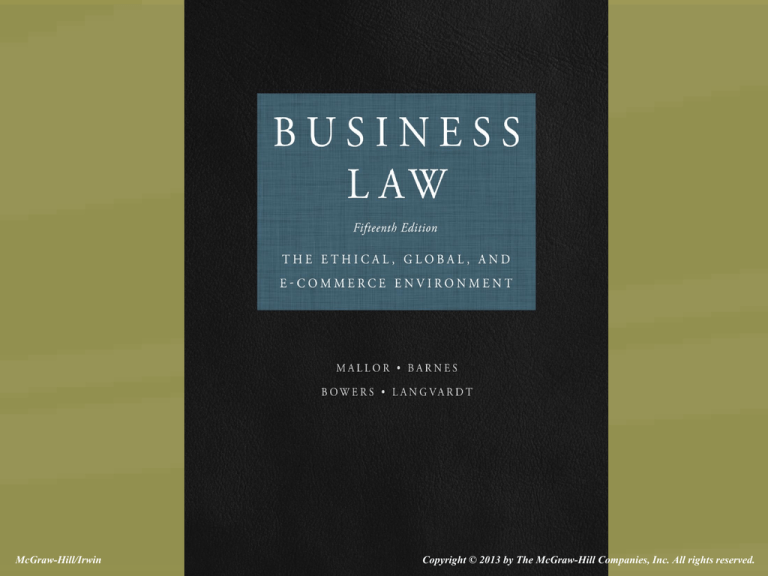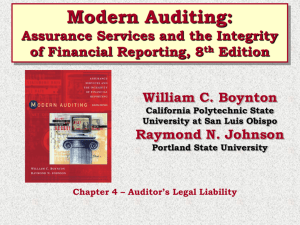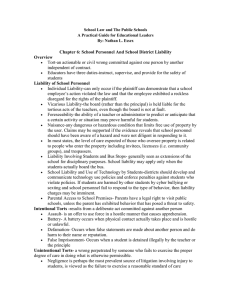
McGraw-Hill/Irwin
46-1
Copyright © 2013 by The McGraw-Hill Companies, Inc. All rights reserved.
P
A
R
T
Corporations
10
• History and Nature of Corporations
• Organization and Financial Structure
of Corporations
• Management of Corporations
• Shareholders’ Rights and Liabilities
• Securities Regulation
• Legal and Professional Responsibilities of
Auditors, Consultants, and
Securities Professionals
46-2
C H A P
T
E R
46
Legal and Professional
Responsibilities of Auditors,
Consultants, and
Securities Professionals
Madness in great ones
must not unwatched go.
William Shakespeare,
Hamlet, Act. 3, Scene 1
46-3
Learning Objectives
• Understand the duties that securities
professionals and accountants owe
to their clients and third parties
• Learn to behave in a manner that
prevents you and your firm from
incurring liability to clients and third
parties
46-4
Overview
• Auditors, consultants, and securities
professionals owe a general duty to their
clients and other persons affected by their
actions to exercise the skill and care of the
ordinarily prudent professional in the same
circumstances
– Professional’s duty to exercise reasonable
care is a subset of negligence standard
– Two elements compose the general duty of
performance: skill and care
46-5
Professionals’ Liability to Clients
• Professionals are not
guarantors of the
accuracy of their work or
that advice they give to
clients will work out well
• However, when clients
sue professionals, there
are three principal bases
of liability: contract, tort,
and trust
46-6
Contractual Liability
• A professional contracts with a client
to perform as agreed with the
implied duty to perform as the
ordinarily prudent person in the
profession would perform
• If the professional fails to perform as
agreed, s/he may be liable for
compensatory damages and
consequential damages
46-7
Tort Liability & Negligence
• A professional is negligent if s/he breaches
the duty to act skillfully and carefully and
proximately causes damages to the client
• The suitability and know-your-customer
rules of the NASD and stock exchanges
require a securities broker to know the
financial circumstances and investment
objectives of the client before
recommending securities or executing
securities transactions
46-8
Contributory &
Comparative Negligence
• Courts generally prevent a professional
from escaping liability merely because
client also acted negligently (contributory
negligence)
– Professional is expected to have skills
superior to a client’s skills
• Some courts allow contributory or
comparative negligence defenses
– See Scioto Memorial Hospital Ass’n., Inc.
v. Price Waterhouse
46-9
Tort Liability for Fraud
• A professional may be liable to a client
for fraud if s/he misstates or omits facts in
client communications and acts with
scienter
– Scienter: knowledge of the falsity of a
statement or a reckless disregard for truth
• Most courts extend a professional’s
liability for fraud to all foreseeable users
of the professional’s work product
46-10
Third Parties & Liability
• In the 1931 Ultramares case, Judge Cardozo
required privity of contract (primary benefit)
to hold a professional liable for negligence
• State courts now adopt one of three tests to
determine whether a nonclient may sue a
professional for negligence:
– Primary Benefit Test
– Foreseeable Users Test
– Foreseen Users and Foreseen Class of Users
Test
46-11
Section 11 & Professionals
• Section 11 of the Securities Act of 1933 states
that an auditor or underwriter may be liable
to a purchaser of securities issued pursuant
to a defective registration statement
– An underwriter is liable for errors in the entire
registration statement
– As an expert, an auditor is liable only for that
part of a registration statement for which the
auditor has issued an opinion about the
financial statements
46-12
Section 12(a)(2) & Professionals
• Section 12(a)(2) of the Securities Act of
1933 imposes liability on anyone who
misstates or omits a material fact in
connection with an offer or sale of a
security that is part of a general
distribution of securities by an issuer
– Direct contact with buyer is required, thus
merely performing professional services is
not enough
46-13
Section 18 & Professionals
• Section 18 of the 1934 Securities
Exchange Act imposes liability on
persons who furnish misleading and false
statements of material fact in any report
or document filed with the SEC under the
1934 Act, such as annual 10-K report,
monthly 8-K report, and proxy statements
– Purchaser or seller of a security must
prove reliance on the defective
document
46-14
Private Securities Litigation
Reform Act of 1995
• The Act imposes significant
public duties on independent
auditors that audit financial
statements of public
companies
• However, the Act limits the
liability of most professionals to
the amount of an investor’s loss
for which the defendant is
responsible
46-15
Sarbanes-Oxley Act
• Section 404 requires public issuers to
include in their annual reports an
“internal control report” acknowledging
management responsibility to maintain
“an adequate internal control structure
and procedures for financial reports”
– www.aicpa.org/sarbanes/index.asp
• Auditors must attest to management’s
assessment of internal controls
46-16
Dodd–Frank Wall Street Reform and
Consumer Protection Act
• Authorizes SEC to issue point-of-sale
disclosure rules when investors purchase
investment products or services (e.g., mutual
funds and investment management services)
• Authorizes the SEC to impose a fiduciary duty
on broker-dealers and investment advisers in
their dealings with their customer
46-17
Professionals & Criminal Liability
• 1933 Act imposes criminal liability for
willful violations of any section, such as
Sections 11, 12(a)(2), and 17(a), or any
1933 Act rule or regulation
• 1934 Act imposes criminal penalties for
willful violations of any section, such as
Sections 10(b) and 18, and any 1934
Act rule or regulation (e.g., Rule 10b–5)
46-18
Ownership of Working Papers
• A client’s personal records, such as
accounting records, are the property of
the client and the professional must return
the records at end of job
• Material created by a professional, such
as working papers produced by
independent auditors, belong to the
professional
– Client has a right of access to working papers
46-19
Document Retention
• The Arthur Andersen case highlights the
rules about document retention
– All professional firms have rules about
document retention and destruction
– Federal law requires all audit or review
working papers to be retained for 7 years
– No requirement to retain documents that
prove professional’s or client’s guilt, as long
as they do not destroy documents (i.e.,
evidence) with the intent to obstruct a
criminal prosecution
46-20
Thought Questions
• Joseph Berardino, former
Arthur Andersen CEO,
testified in an Enron hearing
(Dec. 12, 2002): We made a
professional judgment about
the appropriate accounting
treatment that turned out to
be wrong.
• What is your opinion of the
Enron and Andersen cases
during the past decade?
46-21






